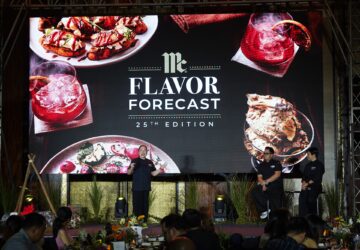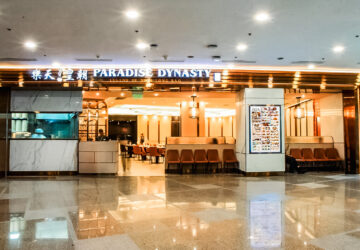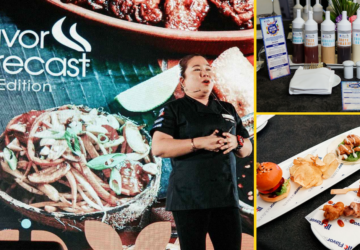



He’s lost. The stage director signals that he has about five minutes to wrap up his presentation. But he’s cool. If he’s in a state of panic, the audience can’t tell. He calmly lets the notes go. Veering away from his speech, he says, “Alright, I’ll wing it.”
That was in the first week of October. Anglo was invited to present at the 21st San Sebastian Gastronomika (SSG) in Basque Country, an annual congress that brings together some of Europe’s—if not the world’s—best chefs and culinary figures. This year, the congress celebrated the 500th anniversary of Elcano’s historic circumnavigation of the world, which explains why the delegation included chefs from Latin America, Asia, and some parts of Europe.
Weeks before, Anglo and I met at a dinner party in Makati. He waves in my direction and asks me over to the table he and his wife Camille shares. He is telling me how he’s already got 25 kilograms of ingredients packed, not including his personal belonging, dreading he would have to pay P5,000 for an extra five-kilo baggage.
“And this is not yet everything. The rest of what we’ll need we will get from Spain,” he says. “We have this friend from Madrid, a very reliable one who is helping us. He says he found a way to bring banana leaves to San Sebastian, so we asked how much?” “Then he says he’s bringing an entire tree for 400 euros!” Camille says with a shock. “We’ll just have to find another way,” Anglo reassures her.

Together with two other Filipinos, their crew stood out in a sea of guests clad in suits and evening dresses. Anglo wore a tan down vest over a plaid shirt, while his sous chef Kurt Somero, a fellow Negrense based in Singapore, wore an olive collarless shirt with sneakers. The only person in his team dressed for the occasion was Kitty Bunag, a Manila-based designer who was helping him set up on stage. She wore a barong with a bayong bag.
Over dinner, a feast prepared by some of the top chefs behind Michelin-starred restaurants in the region, Anglo was his usual self, animated and brimming with humor. Perhaps it was because, despite the isolation of being surrounded by Europeans, he was sharing a table with Filipinos: me, Kitty, Kurt, and Juan, who one could argue is Filipino by association. This crowd soon grew with the addition of Christina Sunae, a Korean-American chef from Argentina raised by a Filipina mother in Angeles, Pampanga.
Anglo shared the same sentiment referencing his Manila practice but three weeks after the congress and back in his apartment in Makati, Anglo still couldn’t shake off the feeling that the experience afforded him. He recounted one particularly moving moment with Carme Ruscalleda, the Catalan chef who’s also the first woman to receive seven Michelin stars and was this year’s SSG keynote speaker.
“When Carme Ruscalleda says there can be generosity even in competition, I was crying. I was in tears because here in the Philippines we have so much crab mentality,” he says.
He told her this personally—and on video—when they met at the dinner dedicated to Ruscalleda at the Basque Culinary Institute. He implied it too during his presentation on the last day of the congress.
But don’t get him wrong, Anglo only wanted to point this out and not churn out more hate. In fact, he pushes for unity in the industry and the need for sharing best practices and knowledge and fostering an exchange of ideas, much like what he saw on the Gastronomika stage with his culinary idols. Because if the greatest faces in the gastronomy were capable of getting together without egos getting in the way, why can't the local food scene do it?
He knew this was the case even before he accepted the invitation to talk in San Sebastian. He anticipated criticisms and eventually sought advice from close friend Chele Gonzalez.
“He was so helpful, he validated everything I did. I say, ‘Chele, I want to make inasal. Is that okay?’ ‘Yeah! You’re from there, do it.’ ‘I want to make binakol. Is that okay?’ ‘That’s cool. They haven’t seen that.’ Then I say ‘I want to do a boodle fight.’ ‘Oh, cool. Do it! Do it!’ ‘No really? It might be too rugged?’ ‘But that's you, JP. You’re rugged.’

But even then, and after returning to the Philippines, just as expected, there were criticisms hurled his way. “I was criticized for shooting my audiovisual in Siargao. I'm not from there naman daw and why am I talking about myself daw?” During this whole debacle on social media, Anglo remained quiet.
So what was he really up to when he decided to shoot in Siargao? Knowing Anglo even in the short time we were together in San Sebastian, everything he does, he does for a reason. He pushed through with the boodle fight-style presentation despite the time constraints because he wanted to represent the vastness of Filipino cuisine faithfully, something he couldn’t do by doing just two dishes. He topped his first dish (chicken inasal) during the demo with latik or coconut curds instead of coating it with burnt coconut the way he’d seen a woman from Sulu do it because Sunae was already doing that in her presentation. So what was it with Siargao?
“You just become highly creative when you’re there. Kasi the ingredients are so limited, it makes you go back to basics,” he says. That’s apart from his love for surfing.
Looking back at this experience, he says the only reason why he was on TV was that the network needed a young chef. “It just happened. I was plucked from the province and then thrown into the arena. I had zero experience whatsoever and I just learned.” He would go on to open Sarsá, a modern Filipino restaurant, the following year—a time people realized that he’s not just a face and that he could actually cook.
While the idea of a Filipino celebrity chef today is almost non-existent, partly because the metrics have shifted (from television ratings to social media reach), Anglo’s brand of celebrity has persisted. He has over 150,000 followers on Instagram where he shares his whereabouts daily. On YouTube, where he’s uploaded his “Hungry with Chef JP” series that originally appeared on CNN along with a new series called “Cooking for the Wife” featuring Camille, he has 18,000 subscribers.
This visibility may explain why some people constantly come for him. The other reason he explained—or rather his friends explained—is that industry leaders themselves look down on other Filipino chefs who are doing the opposite of the status quo.
“Here in the Philippines, the more sosyal, the more pogi points you have,” he says. “But hey, I have a lot of respect for, for example, Chele because he does really good food and because his intentions are pure and that's his training.”
“We should welcome these guys because they're the next generation. We should welcome change, we should help them instead of being threatened,” he says. And that’s just how he is. It comes from his nonchalant demeanor in the face of critics and gritty competition, and his being at peace with the self-imposed mantra that “You can’t be hot forever.”
Apart from Sarsá, which has five branches in Manila, what’s keeping Anglo busy these days, among other things, is organizing private dinners at home. Asked if he will make this an official venture, he says, “Maybe. But we do it just for fun here. We only do it because before when I didn't have this kitchen we would always do it at the beach.”

But Anglo still has a lot of tricks up his sleeve. Together with Camille, he is planning to put up another restaurant where he can create a new, more hands-on concept different from Sarsá. But he’s not revealing anything concrete yet out of fear of being hyped—a dangerous thing if you ask him.
For now, he’s still grateful for the opportunity he had been given in San Sebastian. And like a true comic, he jokes that he already has an idea of what he and his team could do if ever they get invited again. “Maybe a vertical banana leaf, like a vertical boodle fight using coconut as the main ingredient—from the top of the coconut hanggang sa root, using every single part of it. And then to eat, maybe we'll have a ladder or something, you pick and you eat that.”
“Like an interactive art installation?” I ask.
“Yeah.”





